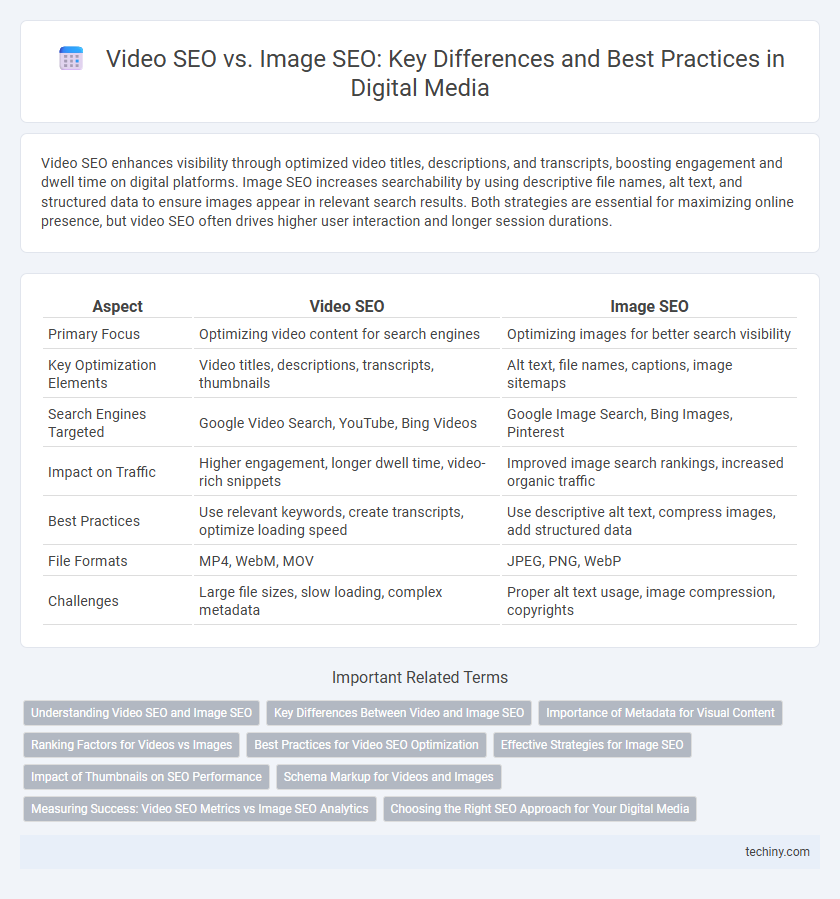Video SEO enhances visibility through optimized video titles, descriptions, and transcripts, boosting engagement and dwell time on digital platforms. Image SEO increases searchability by using descriptive file names, alt text, and structured data to ensure images appear in relevant search results. Both strategies are essential for maximizing online presence, but video SEO often drives higher user interaction and longer session durations.
Table of Comparison
| Aspect | Video SEO | Image SEO |
|---|---|---|
| Primary Focus | Optimizing video content for search engines | Optimizing images for better search visibility |
| Key Optimization Elements | Video titles, descriptions, transcripts, thumbnails | Alt text, file names, captions, image sitemaps |
| Search Engines Targeted | Google Video Search, YouTube, Bing Videos | Google Image Search, Bing Images, Pinterest |
| Impact on Traffic | Higher engagement, longer dwell time, video-rich snippets | Improved image search rankings, increased organic traffic |
| Best Practices | Use relevant keywords, create transcripts, optimize loading speed | Use descriptive alt text, compress images, add structured data |
| File Formats | MP4, WebM, MOV | JPEG, PNG, WebP |
| Challenges | Large file sizes, slow loading, complex metadata | Proper alt text usage, image compression, copyrights |
Understanding Video SEO and Image SEO
Video SEO involves optimizing video content to improve visibility on search engines through metadata, transcripts, and engaging thumbnails, which boosts user interaction and ranking. Image SEO focuses on enhancing images with descriptive alt text, file names, and responsive design to increase image search traffic and improve page load times. Both require tailored strategies to maximize search engine indexing and user experience in digital media.
Key Differences Between Video and Image SEO
Video SEO requires optimizing metadata such as titles, descriptions, and transcripts to improve search engine rankings, while Image SEO focuses more on alt text, file names, and image quality. Videos demand longer engagement times and proper video schema implementation, whereas images prioritize fast loading speeds and responsive display for better user experience. Search engines process video content by analyzing visual and auditory signals, whereas image SEO relies primarily on keyword-rich context and surrounding text for relevance.
Importance of Metadata for Visual Content
Metadata is crucial for both Video SEO and Image SEO as it enhances search engine understanding and indexing of visual content. For videos, detailed metadata such as titles, descriptions, tags, and closed captions improve discoverability and user engagement. Similarly, image metadata including alt text, file names, and structured data helps search engines interpret image relevance, boosting visibility in image search results.
Ranking Factors for Videos vs Images
Video SEO ranking factors prioritize video length, engagement metrics such as watch time and click-through rate, and proper video schema markup to enhance search visibility. Image SEO relies heavily on image optimization elements like alt text, file names, image size, and page load speed to improve ranking in image search results. Structured data and user behavior signals significantly influence video rankings, while image SEO depends more on image relevance and contextual placement within content.
Best Practices for Video SEO Optimization
Video SEO optimization requires a strategic focus on high-quality video content, keyword-rich titles, and detailed descriptions to enhance search engine visibility. Implementing structured data markup, creating engaging thumbnails, and optimizing video transcripts help improve user engagement and indexing by platforms like Google and YouTube. Consistent video sitemap updates and fast-loading video players further boost video SEO performance, outperforming traditional image SEO through richer metadata and interactive elements.
Effective Strategies for Image SEO
Optimizing images for SEO involves using descriptive, keyword-rich file names and alt text to improve visibility in search engine results. Implementing structured data and ensuring fast loading times enhances user experience and boosts rankings on platforms like Google Images. Leveraging responsive image techniques and optimizing image sitemaps further drives targeted traffic, outperforming generic video SEO strategies in visual content discoverability.
Impact of Thumbnails on SEO Performance
Thumbnails play a crucial role in Video SEO by increasing click-through rates and enhancing user engagement, which search engines prioritize for ranking. In contrast, Image SEO relies more on alt tags and file names to improve visibility but benefits less directly from thumbnails. Optimizing video thumbnails with relevant keywords and appealing visuals significantly boosts SEO performance by attracting more organic traffic and reducing bounce rates.
Schema Markup for Videos and Images
Schema markup for videos enhances Video SEO by providing search engines with detailed metadata such as video duration, thumbnail URL, and transcript, improving visibility in rich snippets and video carousels. Image SEO benefits from schema that includes image licensing, captions, and author information, helping search engines understand image context and boost image search rankings. Implementing videoObject schema for videos and ImageObject schema for images ensures structured data compliance and maximizes organic search presence across multimedia content.
Measuring Success: Video SEO Metrics vs Image SEO Analytics
Video SEO metrics primarily focus on viewer engagement indicators such as watch time, click-through rate (CTR), and audience retention, which directly influence search rankings on platforms like YouTube and Google Video. Image SEO analytics emphasize factors like image loading speed, alt text optimization, and image click-through rates, impacting visibility in Google Image Search. Measuring success involves analyzing user interaction, search impressions, and conversion rates tailored to the unique behaviors and algorithms governing video and image content.
Choosing the Right SEO Approach for Your Digital Media
Video SEO enhances user engagement by optimizing video titles, descriptions, and transcripts to improve search engine rankings and increase visibility on platforms like YouTube and Google Video. Image SEO involves optimizing image file names, alt text, and surrounding content to boost site speed and enhance Google Image Search performance. Selecting the right SEO approach depends on your digital media goals, target audience behavior, and content type, ensuring maximum reach and improved organic traffic.
Video SEO vs Image SEO Infographic

 techiny.com
techiny.com